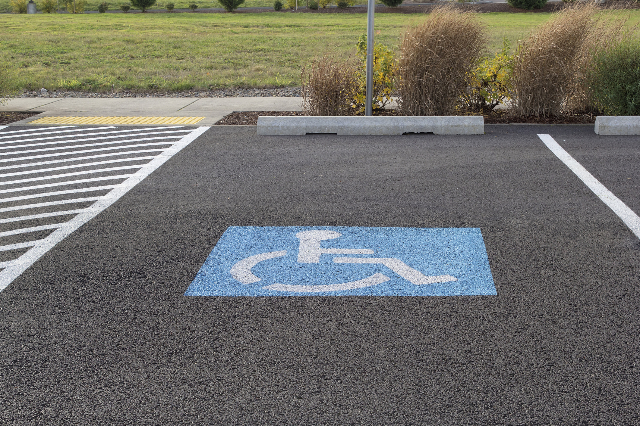Handicap parkers: When they go too far and when they don’t

We fume when some jerk cuts us off on the freeway.
We curse when up to a half-dozen cars blast through an intersection after the traffic light has changed to red.
But the vile violator who may catch the most ire is the handicap parking cheat.
Warrior readers fired a volley of email to Warrior Central recently about those special license plates and temporary placards reserved for the disabled.
Warrior reader Gary told me a tale about parking at a local store and observing an individual parking in a marked handicap space with no license plate or placard visible. When he inquired with the motorist, she said she didn’t have to show it — even though Gary later noticed it sitting on the dashboard.
After he further inquired about why she would get confrontational instead of just hanging the placard from the rear-view mirror, Gary learned the truth — the placard had expired.
By that time, the motorist’s spouse showed up and threatened to kick Gary in the tailpipe.
“Am I not right by asking if they had a placard?” Gary asked. “Maybe you can enlighten the parking populace about displaying the handicap placard.”
In order to legally use a handicap parking space, a motorist must either have a Department of Motor Vehicles-issued license plate or a placard.
“The DMV issues license plates for the permanently disabled and placards for those with permanent or temporary disabilities,” said Kevin Malone, a spokesman for the department. “The application has to be signed off by a doctor.”
Malone said cities and counties also are authorized to issue temporary placards or stickers.
Placards often are acquired by people with multiple vehicles for flexibility, or they can even be used by a caregiver transporting a disabled person.
So when you see a huge truck with a cab so high that drivers and passengers need mountain-climbing gear to get inside, parked in a handicap spot, consider that the vehicle might belong to a caregiver.
To be considered for a placard, a medical professional will review the loss of use of legs or hands, the person’s inability to walk two blocks without resting, heart, lung or circulatory disease, strokes or epilepsy, mental health problems or age and other forms of serious illness for eligibility.
Warrior reader Carol has a handicap placard, but she has a different query: “I was told we could park in a reserved space that also says ’Van Access’ as long as it does not say ’Van Access ONLY.’ We have a friend that parked in the ’Van Access’ spot who also has a placard but not the van, and was ticketed. Can you please clarify this for me?”
Handicap vans generally are equipped with side-loading wheelchair lifts, which is the reason for the special designation.
There are some special rules about van access, but this is the relevant passage from Las Vegas Municipal Code addressing the question: “A person who meets the requirements (of having a handicap plate or placard) may park a vehicle that is not equipped with a side-loading wheelchair lift in such a parking space if the space is in a parking lot with fewer than 60 parking spaces.”
So in other words, if it’s a big lot with more than 60 spaces, you can’t park there with a placard. But if it has fewer than 60, it’s all right to park in the designated van space.
Warrior reader Jim asks: “Do UPS and FedEx drivers have some sort of dispensation from following the laws of the road? They park in handicap spots, on red curbs, in no-parking areas and they run stop signs, speed and never obey traffic signs. Cops seem to look the other way.”
No, Jim, these drivers don’t have any special privileges, and that includes parking in handicap spaces. Only emergency vehicles responding to an incident are immune. And, contrary to popular belief, U.S. Postal Service vehicles also must obey traffic laws except for those related to stopping and parking on painted curbs and near private driveways.
By the way, the minimum fine for a handicap parking violation is $250 for the first or second offense and a minimum of $500 and maximum of $1,000 for a third offense.
Airport Connector update
Last week, I told you about how the early work on the Airport Connector project that began Sunday night wouldn’t be too disruptive because most of the work would be done on the road shoulders and in the median.
That’s changed.
Citing an updated schedule, Clark County officials say one lane of the eastbound 215 Beltway offramp to the northbound Airport Connector (Exit 10) and one lane of the westbound Beltway onramp and the Hidden Well Road exit from the southbound Airport Connector to Bermuda Road will be restricted in addition to the shoulder along George Crockett Road from Bermuda Road to where it merges with the northbound connector.
Lane restrictions are planned for a year and will be in place 24 hours a day, even though work is only expected to occur from 6 a.m. to 3:30 p.m. County officials expect traffic to be disrupted and are encouraging motorists to use alternative routes.
The work is in preparation for the two-year Airport Connector Phase 2 project featuring a flyover bridge that will carry exiting airport and airport bypass traffic over the top of the highway to the eastbound Beltway.
Questions and comments should be sent to roadwarrior@reviewjournal.com. Please include your phone number. Follow the Road Warrior on Twitter @RJroadwarrior.